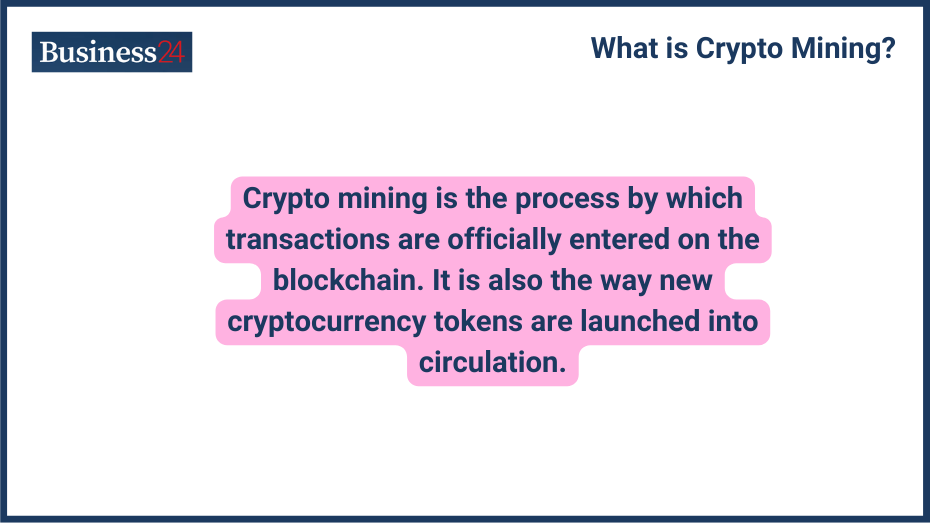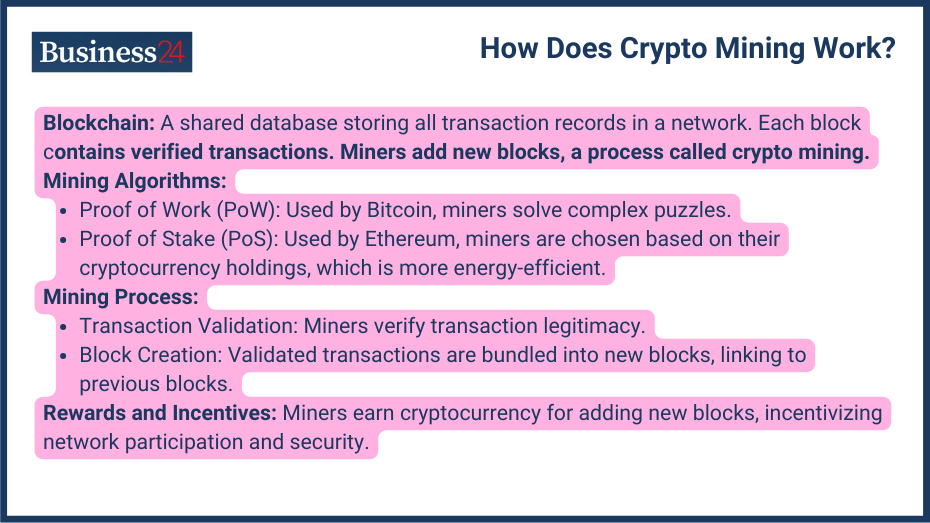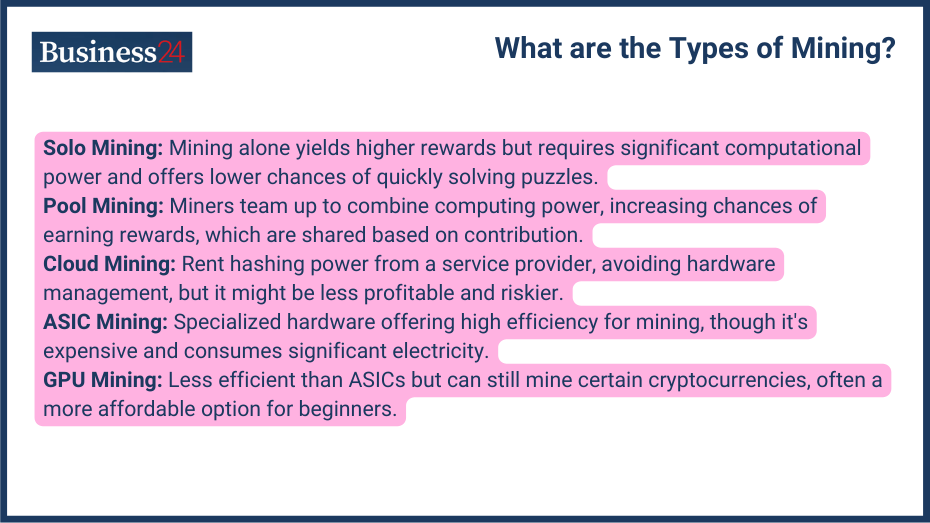
Crypto mining is the process by which transactions are officially entered on the blockchain. It is also the way new cryptocurrency tokens are launched into circulation.
Crypto mining is simply a process that is used to validate new transactions and generate new coins. In the early days of crypto, crypto mining was very popular. When Bitcoin was launched, the crypto mining was done on CPU. There have been many technologies and methods changed in crypto mining throughout the years.
What is the Definition of Crypto Mining?
When any transaction in the blockchain is done that needs a complex mathematical puzzle to be solved, the first miner or developer who successfully solves the puzzle gets to add a new block of verified transactions to the blockchain. This process of solving puzzles and adding blocks is known as crypto mining, and as a reward, the miner is compensated with cryptocurrency or transaction fees.
Crypto mining started with Bitcoin in 2009. At first, people could mine using personal computers. However, as Bitcoin’s popularity grew, mining became more difficult, making it harder to mine coins with regular CPUs. This challenge led to the creation of hardware called ASICs (Application-Specific Integrated Circuits), designed specifically for efficient crypto mining.
If you are unfamiliar with crypto mining, you may connect the word “mining” to traditional mining, but there is no extraction of physical matter in crypto mining; instead, crypto miners help verify the transaction and are rewarded in return.
What exactly is crypto mining?
Crypto mining is done by solving cryptographic hash functions. These functions take input data into a unique string of characters called a hash. The key thing about hash functions is that while it’s very hard to figure out the original data from the hash, it’s easy to check if a given input matches the expected hash. Crypto mining algorithms use this feature to create a secure and reliable method for validating transactions.
Miners are paid with newly created coins or transaction fees for their computational power to secure the network and validate transactions. This pushes the miners to participate in the network and maintain its security and functionality.
Why is crypto mining bad?
The most discussed problem in crypto mining is its high energy consumption. Modern crypto mining rigs, particularly those using ASICs, require substantial electricity. This can strain power grids and contribute to greenhouse gas emissions if the electricity is generated from fossil fuels.
This high energy consumption associated with crypto mining raises concerns about its environmental impact. If the electricity used for mining comes from non-renewable sources, it can contribute to climate change and air pollution.
How Does Crypto Mining Work?

- Blockchain Technology: Cryptocurrencies operate on blockchain technology. Blockchain is a shared database that stores all transaction records within a network. Each block in the blockchain contains a set of verified transactions, and miners work to add new blocks to the chain, known as crypto mining.
- Mining Algorithms (Proof of Work, Proof of Stake): This could be new for you, but cryptocurrencies use different mining algorithms. The most common and well-known algorithm is Proof of Work (PoW), which is the one used by Bitcoin.
An alternative algorithm that has gained popularity is Proof of Stake (PoS), which Ethereum announced will be used in their network. In PoS, the chance of a miner being chosen to validate the next block depends on how much cryptocurrency they hold in the network. This approach is generally considered to be more energy-efficient compared to Proof of Work (PoW). - The Mining Process (Transaction Validation, Block Creation): When a cryptocurrency transaction occurs, it’s broadcast to the entire network. Miners then compete to validate the transaction by verifying its legitimacy and ensuring it hasn’t been spent twice.
Once a miner successfully validates a set of transactions, they bundle them into a new block. This block also references the previous block in the chain, creating a chronological record of all transactions.
- Rewards and Incentives: The first miner to solve the cryptographic puzzle and add a new block to the blockchain is typically rewarded with newly minted cryptocurrency coins or transaction fees. These rewards incentivize miners to participate in the network and dedicate their computational power to securing it. The difficulty of the mining puzzles is adjusted automatically to maintain a desired block creation rate.
Is crypto mining illegal?
No, crypto mining is not illegal. However, the legality can vary depending on your location and the specific regulations in place. Some practices associated with crypto mining can be against the law, like there might be regulations or restrictions on the amount of electricity that can be used for crypto mining, or there might be regulations or initiatives promoting using renewable energy sources for mining operations.
What is Bitcoin Mining?
Bitcoin mining is the same process I have explained earlier. Bitcoin was the first crypto and was also the one to be mined first. Bitcoin mining uses specialized hardware like ASICs to solve complex mathematical puzzles and relies on the Proof of Work (PoW) mining algorithm.
The difference between Bitcoin mining and other mining can be that Bitcoin mining relies heavily on ASICs due to the high difficulty of its PoW puzzles. Other cryptocurrencies might use different algorithms that can be mined with less specialized hardware like GPUs.
What are the Types of Mining?

Types of crypto mining:
- Solo Mining: It’s not always that group of miners do the crypto mining; you can operate the mining solo, too. Rewards will be higher as you don’t have to distribute the chances are less to solve a puzzle fast, especially for popular currencies with great mining difficulties. Also, you must be equipped with advanced tech because solo mining requires significant computational power to be profitable.
- Pool Mining: Pool mining means teaming up with miners to combine your computing power. This boosts your chances of solving blocks and earning rewards. These rewards are shared among the group based on how much computing power each miner contributes. Pool mining provides a steadier income than mining alone, though the individual rewards are usually smaller.
- Cloud Mining: In Cloud mining, you rent hashing power from a cloud service provider. Because it’s not always possible that you can manage your own equipment, instead of managing your own mining hardware or software, you simply pay a fee for the computing power you rent. This option is convenient for beginners who don’t want to invest in hardware or deal with the technical setup of a mining rig. However, cloud mining services might be less profitable than owning your own equipment, and there’s a risk of scams.
- ASIC Mining: Application-Specific Integrated Circuits (ASICs) are specialized hardware designed specifically for efficient crypto mining, and it is widely used. ASIC offers the highest hash rate (computing power) for mining certain algorithms like Bitcoin’s PoW. However, ASICs are expensive, require significant electricity consumption, and may become obsolete as mining difficulty increases.
- GPU Mining: Graphics Processing Units (GPUs) were initially used for crypto mining before the rise of ASICs and are now not in much use. While generally less efficient than ASICs, GPUs can still mine some cryptocurrencies that utilize algorithms less suited for ASICs. They may be a more affordable option for beginners than ASICs, but their profitability depends on the specific cryptocurrency and current market conditions.
What equipment is Needed for crypto mining?
Equipment used in crypto mining:
- Mining Hardware (ASICs, GPUs, CPUs): The most important part of crypto mining is the hardware used. The choice of hardware depends on the cryptocurrency you plan to mine and the mining method you choose. For popular currencies like Bitcoin, ASICs are the most efficient option, but they come with a high upfront cost and energy consumption. GPUs can be used for some cryptocurrencies and offer a more affordable entry point, while CPUs are generally unsuitable for serious mining due to their lower processing power.
- Software Requirements: Crypto mining software is necessary to interact with the blockchain network, broadcast transactions, and manage the mining process. The software required will vary depending on the chosen cryptocurrency and mining method. Some popular mining software options include CGMiner, EasyMiner, and Bitcoin Miner.
- Setting Up a Mining Rig: If you are not taking external help and choose to set up your own mining hardware, you must set up a mining rig. To set up a mining rig, you must assemble a mining device, power supply unit, and cooling system, install the mining software, and configure it for the mining.
- Energy Consumption and Costs: As I have explained earlier, crypto mining is a high energy consumption work, particularly when using ASICs. So, for profitability, you have to analyze the consumption and cost of the energy.
What are the Benefits of Crypto Mining?
Benefits of crypto mining:
- Earning Cryptocurrencies: The reason crypto mining is so popular is because of the opportunity to earn cryptocurrency rewards. Miners worked hard to introduce a block in the network and paid back in crypto. Miners are a very important part of a blockchain protocol as they work towards the scalability and security of the network.
- Supporting Blockchain Networks: As mentioned above, miners play a vital role in securing and maintaining the integrity of blockchain networks. Validating transactions and adding new blocks contribute to the decentralized and trustless nature of these systems.
- Potential for Profitability: Crypto mining can be profitable if done with large-scale mining farms. However, the profitability of crypto mining depends on factors like chosen cryptocurrency, mining difficulty, hardware efficiency, and electricity costs, which can differ from place to person.
- Decentralization and Security: The decentralized nature of blockchain is supported by crypto mining. Blockchain works on a distributed network of miners to validate transactions and secure the network. This decentralization helps to prevent fraud and censorship.
How does crypto mining pay?
There are two ways crypto mining pays, one through block reward and the other through transaction fees in the network. We have talked about the block reward previously. The transaction fees are paid by users who send cryptocurrency transactions on the network, from which miners can earn a portion of the transaction fees included in the block they add.
What are the Risks and Challenges of Crypto Mining?
The risks and challenges of crypto mining are:
- High Energy Consumption: High energy consumption of crypto mining can lead to high burning of fossil fuels, leading them to burn the nonrenewable fuels faster, which are less in the depository.
- Environmental Impact: A large amount of nonrenewable energy has to be produced for crypto mining due to the high energy consumption, which can lead to the emission of greenhouse gas
- Initial Setup Costs: You should have a good balance in your account to start crypto mining cause it can require high upfront costs. You’ll need to invest in specialized hardware like ASICs or GPUs, and there might be additional expenses for electricity and cooling systems.
- Market Volatility and Profitability: The profitability of crypto mining is highly dependent on the market price of the cryptocurrency you’re mining, so keep in mind the prices. If the price of the coin drops, your mining operation might become unprofitable.
- Regulatory and Legal Issues: The regulatory landscape surrounding cryptocurrencies and crypto mining is still evolving. In some regions, there might be regulations restricting or discouraging crypto-mining activities.
How to Start Crypto Mining?
Here is the process of how to start crypto mining:
- Choosing the Right Cryptocurrency: The first step is researching the market and looking for a crypto that can give you profitability. Analyze factors like Research differences, mining difficulty, and your budget for hardware. Popular options for crypto mining are Bitcoin, Ethereum, Litecoin, and Monero.
- Selecting Mining Hardware and Software: There are various hardware and software available now for mining, and according to the crypto chosen, the specific hardware and software are set. According to your need and budget choose the software and hardware for mining.
- Joining Mining Pools: For most beginners, joining a mining pool is recommended because it can be very hard for you to navigate the path alone. Pooling with other miners increases your chances of earning rewards compared to solo mining. There are various mining pools where you can compare their fees and payout structures.
- Monitoring and Optimizing Performance: Once your mining rig is set up, you are all set up for mining now; you have to monitor its performance and profitability. There might be opportunities to optimize your setup for better efficiency or adjust your mining pool participation.
What are the Economic Implications of Crypto Mining?
Different economic implications of crypto mining:
- Impact on Electricity Markets: Crypto mining can put a lot of strain on the electricity grid in the region, particularly in areas where power generation capacity is limited. This can lead to increased electricity prices for consumers. However, crypto mining can also push for investments in renewable energy sources to meet the growing demand for electricity.
- Mining Difficulty and Profitability: The mining difficulty for many cryptocurrencies is adjusted automatically to maintain a desired block creation rate. As more miners join the network, the difficulty increases, making it harder to earn rewards. This can impact the overall profitability of crypto mining, especially for smaller miners.
- Market Competition Among Miners: With the advanced technology and popularity of cryptos, competition in mining has also increased drastically. The over-competition can result in the compromise of the decentralization and security principles that cryptocurrencies are built upon.
- Economic Incentives for Miners: Due to competition, the reward for miners can also be lowered, or the mining difficulty can be too high, which can discourage miners from participating and can affect the network.
What is the Future of Crypto Mining?
New technologies like quantum computing or new algorithms can threaten the security of blockchain networks that depend on traditional cryptographic algorithms. Continuous R&D is happening to stop the quantum computing attacks. Also, governments might introduce regulations to address problems about energy consumption or money laundering, which can affect crypto mining in many ways.
FAQs
Q: What is crypto mining on an iPhone?
Crypto mining on an iPhone is generally not practical or profitable. iPhones and other mobile devices lack the processing power required for efficient crypto mining. Additionally, the battery drain and heat generation would likely outweigh any potential rewards.
Q: What is a crypto mining app?
There are some mobile apps that claim to offer crypto-mining functionality. However, these apps are generally ineffective and may not be legitimate.
Q: Is crypto mining profitable?
The straight answer is yes if done right. The profitability of crypto mining depends on various market factors.
Q: Is Bitcoin mining profitable?
Bitcoin mining can be profitable, particularly for large-scale mining operations with access to efficient ASIC hardware. However, profitability can fluctuate significantly depending on the market price of Bitcoin and the difficulty of mining. It’s crucial to do you.
Disclaimer
eToro is a multi-asset platform which offers both investing in stocks and cryptoassets, as well as trading CFDs.
Please note that CFDs are complex instruments and come with a high risk of losing money rapidly due to leverage. 51% of retail investor accounts lose money when trading CFDs with this provider. You should consider whether you understand how CFDs work, and whether you can afford to take the high risk of losing your money
This communication is intended for information and educational purposes only and should not be considered investment advice or investment recommendation. Past performance is not an indication of future results.
Copy Trading does not amount to investment advice. The value of your investments may go up or down. Your capital is at risk.
Don’t invest unless you’re prepared to lose all the money you invest. This is a high-risk investment and you should not expect to be protected if something goes wrong. Take 2 mins to learn more
eToro USA LLC does not offer CFDs and makes no representation and assumes no liability as to the accuracy or completeness of the content of this publication, which has been prepared by our partner utilizing publicly available non-entity specific information about eToro.
